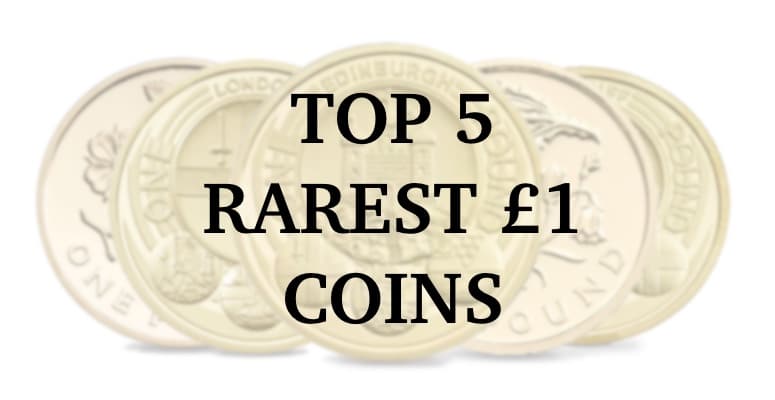The general decline of the purchasing power of the pound led to the decision that the £1 unit of currency was better suited to a coin rather than a banknote. The first £1 coins were then introduced in April of 1983. The £1 coin has always been a representation of all four Home Nations within the United Kingdom with the various collections released focusing on landmarks and national emblems that represent each of countries. After 30 years-worth of coin designs, we’re counting the top 5 rarest £1 coins that collectors are currently looking for.
What are the top 5 rarest £1 coins?
Now that the old-style £1 coins have officially ceased to be legal tender, many collectors are willing to pay good money to ensure they have the complete collection. If you have found a so-called ‘round pound’ in your change that’s been stashed away, see if we’ve included it on our list of the top 5 rarest £1 coins and you could be in with a profit.
1. 2011 Edinburgh £1 Coin
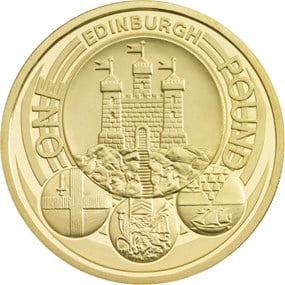
Mintage = 935,000
Estimated Value = £8
By far the rarest of any £1 coin to have been released is the 2011 Edinburgh £1 coin. The coin was released in 2011 as the second part of a new ‘City Series’ created by the Royal Mint. The series highlighted the capital city of each of the four Home Nations that make up the United Kingdom with this particular coin featuring Edinburgh, the capital city of Scotland.
The reverse design of the coin, created by Stuart Devlin, features the beautiful Edinburgh castle which sits on Castle Rock and towers 80m above its city. Built in 1103, the castle has been both a royal residence and a military base for over 900 years and is the most besieged point in Britain. As undoubtedly one of the most iconic landmarks of Edinburgh which can be seen in all directions for miles around, Edinburgh Castle was the perfect choice to represent Scotland’s capital city.
Below the flag of Edinburgh are the three other coin designs representing the other capital cities of the UK. The leftmost image is for London, the centre is for Cardiff, and the right image is for Belfast. Including the designs of the other coins in the collection is a testament to the respect between the countries and a reminder of the strength of the United Kingdom as a whole.
The edge inscription of the coin reads ‘NISI DOMINUS FRUSTRA’ which is the motto of the City’s coat of arms and translates to ‘it is vain without the Lord’.
The mintage for the 2011 Edinburgh £1 coin was just under one million, an incredibly small number in comparison to every other of the old-style £1 coins to have been minted. The low mintage has resulted in these coins selling for around £8 on eBay, with particularly excellent condition versions of the coin fetching as much as £10.
2. 2011 Cardiff £1 Coin
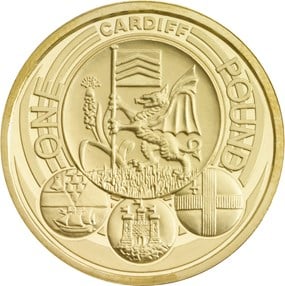
Mintage = 1,615,000
Estimated Value = £6
In second place for the rarest £1 coin is the 2011 Cardiff £1 coin. The coin was released as the second part of the ‘City Series’ in 2011 along with the previously mentioned 2011 Edinburgh £1 coin but in this case features the capital city of Wales.
The reverse design was once again created by Stuart Delvin and puts the spotlight on Cardiff, Europe’s smallest capital city. The flag of Cardiff, which can be seen on the design, features the symbolic fiery red dragon that has been the proud emblem of Wales for over 1000 years. The dragon’s origin is believed to have come from as far back as the Romans but was officially made an emblem of Wales around 655AD when it became known as the Red Dragon of Cadwaladr.
The edge inscription of the coin reads ‘Y DDRAIG GOCH DDYRY CYCHWYN’ which translates to ‘the red dragon shall lead’ and is the motto of the City’s arms. As with the Edinburgh coin, the three flags from the other capital cities within the UK are displayed below Cardiff’s feature image.
The mintage figure is slightly higher for the 2011 Cardiff £1 coin than for the Edinburgh coin, but it is still very low compared to the majority of the other old £1 coins that have been released. The coin currently sells for around £6 if it is in good condition although there are many examples of it selling for up to £10 or even more.
3. 2010 London £1 Coin
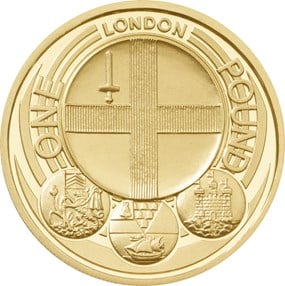
Mintage = 2,635,000
Estimated Value = £3.50
In third place is the final of the Royal Mint’s ‘City Series’ to be featured on the list, the 2010 London £1 coin. Different to the previously mentioned coins of the same series, the London version of the coin was released in 2010 alongside the coin dedicated to Belfast.
As expected, the reverse design by Stuart Delvin focuses primarily on highlighting the City of London, the most populated capital city in the United Kingdom. The flag of the City of London is perhaps the simplest of all the capital cities featured in the ‘City Series’ but it is still a proud representation of the iconic tourist hotspot. The design is based on the flag of England with St George’s Cross at the centre but the difference lies in the added sword that sits in the top left quarter of the flag.
The sword is said to represent that which was used to behead the patron saint of the city, Saint Paul, in 64AD. Unique to this flag is that the sword must always be pointing upward. This means that if the flag’s intended purpose is to be hung on its side as a banner, a different version of the design should be printed with the sword facing hoist but still on the left side.
The edge inscription is of the motto of the arms and reads ‘DOMINE BIRIGE NOS’ which translates to ‘Lord, deliver us’. As with the other coins in the series, the flags of Wales, Belfast, and Edinburgh are featured below that of London.
With a mintage of over 2.6 million, the value of these coins is certainly not as high as for the Edinburgh or Cardiff versions. If you’ve held onto one of these coins, you should be looking to sell it for around £3.50 although there are examples of particularly excellent conditions coins fetching up to £5.
4. 2014 Floral Emblem of Scotland £1 Coin
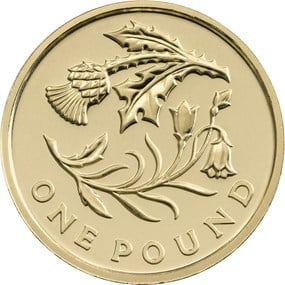
Mintage = 5,185,000
Estimated Value = £3
In fourth place on our list is the 2014 Floral Emblem of Scotland £1 coin. The coin was minted as part of a new series by the Royal Mint to celebrate each of the four Home Nations within the United Kingdom, this time with a focus on the national flowers of each country. This particular coin was made in honour of Scotland and has the lowest mintage of any in the collection.
The reverse design of the coin was created by expert designer Timothy Noad and features the floral emblem of Scotland, a thistle. The thistle is a purple-flowered weed that has become a beloved emblem of Scotland and a symbol of courage and loyalty to those who live there. The flower can be found just about everywhere, from gardens and parks to the uniforms of the police!
The prickly imagery of a thistle is balanced out by a delicate Scottish bluebell that sits below the aggressive-looking weed. The bluebell is cited by some as also being the national flower emblem of Scotland and represents humility and gratitude, making it the perfect partner to the thistle. The edge inscription of the coin reads ‘NEMO ME IMPUNE LACESSIT’ which is the Latin motto of the Order of the Thistle and translates to ‘No one attacks me with impunity’.
With over 5 million of these coins minted in 2014, they are certainly not the rarest. Despite this, the coins are still sought after by collectors, particularly now they are no longer in circulation. A good quality version of the coin sells for around £3 on eBay although lower quality coins can usually be bought for much cheaper as part of a job lot.
5. 2013 Floral Emblem of Wales £1 Coin
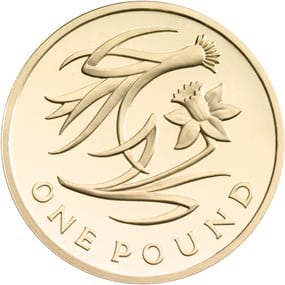
Mintage = 5,270,000
Estimated Value = £2.50
In joint fifth place for the top 5 rarest £1 coins are the 2013 Floral Emblem of Wales £1 coin and the 2013 Floral Emblem of England £1 coin. First, we’ll focus on the coin dedicated to the national flower emblem of Wales. The reverse images of both the coins were designed by Timothy Noad.
As with the coin created for Scotland, this coin features two different flowers that have both become known as national emblems. Laying across the top of the coin’s design is a leek whose origins date back to before the Romans came to Britain. The common leek was thought to have magical properties that could ward off evil spirits and help to foretell the future. Whilst in modern times the leek is more commonly used to make soups, its image was the ideal choice to represent the country of Wales on the 2013 coin.
Below the leek on the coin’s design is a single daffodil, a less commonly used national emblem of Wales. Daffodils can often be seen worn on the lapels of Welshmen on St David’s Day thanks to their regular appearance in early spring which happens to coincide with the patriotic day. The edge inscription of the coin reads ‘PLEIDIOL WYF I’M GWLAD’ which translates to ‘True am I to my country’.
If you’re looking to sell the 2013 Floral Emblem of Wales £1 coin then you should be able to fetch around £2.50 on eBay. As with the Scottish version of the coin, the demand for this version is still there from collectors looking to complete the set, despite the very high mintage figure.
= 5. 2013 Floral Emblem of England £1 Coin
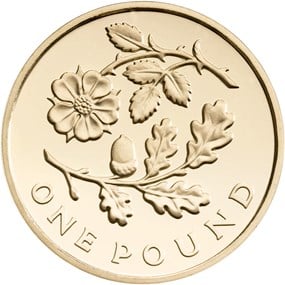
Mintage = 5,270,000
Estimated Value = £2.50
The final coin of this list and in joint fifth position is the 2013 Floral Emblem of England £1 coin. This was the first of the floral emblem series to have been released and marked the first floral release since the 1984 series was started.
This time focusing on the national flower of England, the reverse design features a single rose across the top of the coin and an oak branch beneath it. The English rose, also known as the Tudor rose, was adopted by Henry VII as the emblem of peace after the War of the Roses. The War of the Roses was fought between the royal house of Lancashire who wore red roses, and the royal house of York who wore white roses. The resulting Tudor rose combined both colours and is used to this day by sporting teams across the country.
The edge inscription of the coin reads ‘DECUS ET TUTAMEN’ which translates to ‘An ornament and a safeguard’ which appears on all of the old standard UK £1 coins. The writing actually refers to the inscription itself which was put onto the coins to deter coin-clipping – the act of shaving off a small portion of a precious metal coin for profit.
The 2013 Flower Emblem of England £1 coin has the same mintage as the Wales version of the coin and usually sells for around the same amount. Good quality examples of the coin sell for up to £2.50 but we recommend keeping an eye out for a dip in the number of listings or else you could end up selling it for less.
Final Thoughts
Now that you know the top 5 rarest £1 coins it might be worth checking all your old coats and bags to see if you have any laying around. After being taken out of circulation, many collectors are still looking for these coins to complete their collections, so it’s the perfect time to sell.
If you have any questions relating to the coins mentioned in this article, please feel free to contact us here.
